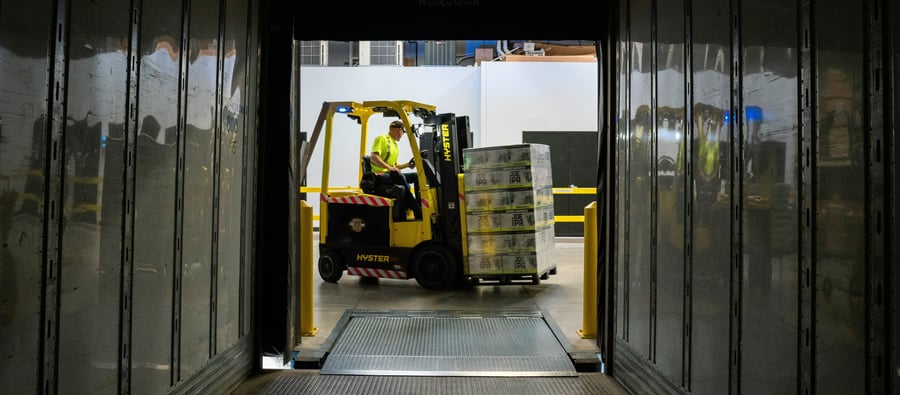Ergonomics in action: How to reduce high-risk postures and prevent MSDs
Musculoskeletal Disorders (MSDs) account for nearly 30% of all workers' compensation costs, according to the Bureau of Labor Statistics (BLS). These injuries, caused by repetitive motions, high-risk postures, and excessive strain, lead to higher injury rates, lost productivity, and increased workers’ compensation expenses.
The good news? Employers can reduce MSDs risks by implementing ergonomic best practices and leveraging wearable technology that provides real-time feedback on high-risk movements.
Are your employees at risk of ergonomic injuries?
If your employees perform repetitive tasks, maintain awkward or high-risk postures for extended periods, or lift heavy objects frequently, they may be at risk of MSDs (also called repetitive motion injuries or repetitive stress injuries) like carpal tunnel syndrome, back pain, and tendonitis.
Assessing workplace ergonomic risks
To evaluate ergonomic risks in your workplace, ask key questions like:
- Have employees reported discomfort, strain, or MSD symptoms?
- Do workers frequently perform high-repetition tasks (100 reps/hour to 2,000/day)?
- Are employees lifting heavy objects—20+ lbs frequently or 50+ lbs occasionally?
- Do tasks involve high-risk postures, such as bending, twisting, or overreaching?
Our drivers will lift about 12,000 lbs a day. If you go to the gym, you may lift 12,000 lbs a year.
National Senior SH&E Development Manager
Food and Beverage Manufacturer
Three Tips to Reduce High-Risk Postures
Bending
Risk: Bending at the waist instead of using the legs increases stress on the lower back. In fact, when you bend at the waist to lift, the pressure on your back is approximately 10 times the actual weight of the object you’re lifting.
Safer alternative:
- Face the object you are moving.
- Keep your back straight.
- Bend at the hips and knees together, lowering your body towards the ground.
- Push through your feet, legs, and hips to return to standing.

Overreaching
Risk: Extending too far to lift an object strains the back and shoulders.
Safer alternative:
- If possible, move your body as close as possible to the object you’re lifting.
- If you can’t move your body closer, try to pull the item closer to you using a “pick stick” or while bending minimally at the waist.
- If the above options aren’t possible, try “building a bridge” by placing one arm on the surface in front of you to help support your body and share the stress on your back.

Twisting
Risk: Twisting the spine while lifting increases strain and risk of disc injuries.
Safer alternative:
- Position your toes and hips toward the object before lifting.
- If the object is behind or to the side, pivot your entire body rather than twisting at the waist.

Avoidable vs. Unavoidable High-risk Postures
Not all high-risk movements can be eliminated, but understanding what’s avoidable versus unavoidable can help drive workplace improvements.
Avoidable High-risk Postures
If an employee has adequate space and proper equipment to safely move an object, a high-risk posture is considered avoidable.
For example, if an employee is moving a box from a cart or pallet, as long as they have the space around them to move properly, employees can make significant reductions in the avoidable high-risk postures they perform. Wearable technology can help them become aware of the way they’re moving through real-time feedback.
Unavoidable High-risk Postures
When space or equipment limitations prevent proper lifting techniques, a high-risk posture is considered unavoidable.
For example, if an employee is removing a box from a cart or pallet and there isn’t sufficient space to reach it or get close to it, it becomes an unavoidable high-risk posture. This often happens with objects at the back of a pallet, or on the back of a shelf.
Wearable tech data can help employers find ways to reduce these dangerous postures that are inevitable. This can be done by changing the way a workstation is set up or by using new equipment.
Using Wearables to Reduce High-risk Postures
Wearable safety devices detect unsafe movements and provide real-time coaching to employees, reinforcing safer habits.
Key benefits of wearables to avoid high-risk postures:
- Instant feedback: Alerts employees when they bend, twist, or overreach improperly.
- Sustained behavior change over time: Repeated alerts help workers build safer movement habits.
- Actionable data for employers: Identifies trends in unsafe movements and areas where workstation adjustments can reduce risks.
Watch how Moss Bros. Auto Groups reduced movement injuries with Kinetic's Reflex Wearable Platform.
Final thoughts
A smart ergonomics program combined with real-time feedback from wearables can significantly reduce workplace injuries and improve employee well-being.
Take proactive steps to protect your workforce. Download our Safe Lifting Checklist to identify high-risk movements and implement safer lifting techniques.
Safety talk information is for general guidance only and should not be relied upon for medical advice or legal compliance. Recommendations provided are general in nature; unique circumstances may not warrant or may require additional safety procedures and considerations. Kinetic, its affiliates and employees do not guarantee improved results upon the information contained herein and assume no liability in connection with the information or the provided suggestions. Kinetic does not make any warranty, expressed or implied, that your workplace is safe or complies with all laws, regulations, or standards.
Learn more about workplace safety.
Subscribe to Kinetic's workplace safety newsletter, to get content from industry experts delivered straight to your inbox.
Related Posts

Revolutionizing workers' comp: The role of technology in injury prediction
.jpg?width=900&name=REFLEX%20banner%20photo%20(1).jpg)


